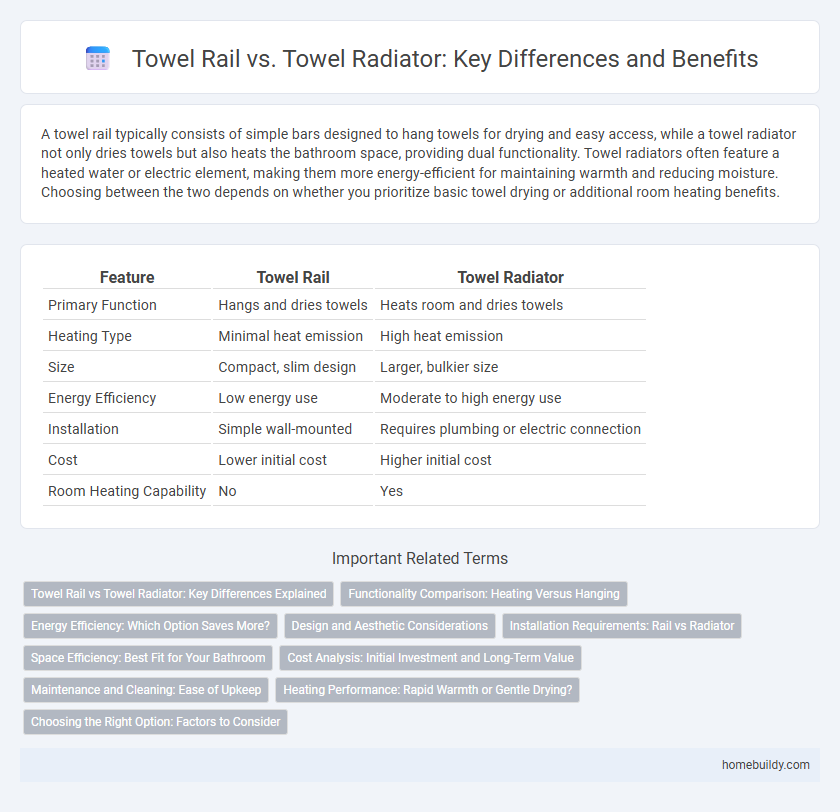A towel rail typically consists of simple bars designed to hang towels for drying and easy access, while a towel radiator not only dries towels but also heats the bathroom space, providing dual functionality. Towel radiators often feature a heated water or electric element, making them more energy-efficient for maintaining warmth and reducing moisture. Choosing between the two depends on whether you prioritize basic towel drying or additional room heating benefits.
Table of Comparison
| Feature | Towel Rail | Towel Radiator |
|---|---|---|
| Primary Function | Hangs and dries towels | Heats room and dries towels |
| Heating Type | Minimal heat emission | High heat emission |
| Size | Compact, slim design | Larger, bulkier size |
| Energy Efficiency | Low energy use | Moderate to high energy use |
| Installation | Simple wall-mounted | Requires plumbing or electric connection |
| Cost | Lower initial cost | Higher initial cost |
| Room Heating Capability | No | Yes |
Towel Rail vs Towel Radiator: Key Differences Explained
Towel rails are primarily designed for drying towels with minimal heat output, typically featuring simple, sleek bars that allow air circulation. Towel radiators serve a dual function, combining towel drying with room heating through higher wattage and integrated heating elements. Key differences include heating capacity, installation complexity, and energy efficiency, with towel radiators offering more warmth and often requiring plumbing connections.
Functionality Comparison: Heating Versus Hanging
A towel rail primarily serves the purpose of hanging towels for convenient access and drying, while a towel radiator combines this functionality with effective room heating. Towel radiators use integrated heating elements or connect to a central heating system to provide warmth, enhancing bathroom comfort by drying towels more quickly and heating the space. In contrast, towel rails typically lack heating capabilities, focusing solely on towel storage and drying through air circulation.
Energy Efficiency: Which Option Saves More?
Towel radiators typically provide higher energy efficiency compared to towel rails due to their integrated heating elements, which deliver consistent warmth and faster drying times. Towel rails mainly rely on ambient room heat, leading to longer drying periods and increased energy usage if paired with separate heating sources. Choosing a towel radiator can reduce overall energy consumption while maintaining optimal bathroom comfort.
Design and Aesthetic Considerations
Towel rails feature minimalist, open-bar designs ideal for modern, sleek bathrooms, emphasizing simplicity and unobtrusive elegance. In contrast, towel radiators often combine heating efficiency with decorative elements, such as curved tubes or intricate patterns, serving as both functional heaters and statement pieces. Selecting between the two depends on desired visual impact and integration with bathroom decor, balancing form with function.
Installation Requirements: Rail vs Radiator
Towel rails typically require lighter wall mounts and simpler plumbing connections, making them easier to install in bathrooms with limited space or existing heating systems. In contrast, towel radiators demand more robust support due to their heavier weight and need integration with the central heating or electric system, often requiring professional installation. The choice between rail and radiator installation depends on the structural capacity of the wall and the heating system compatibility.
Space Efficiency: Best Fit for Your Bathroom
Towel rails are typically slimmer and designed for minimal space usage, making them ideal for small bathrooms where floor or wall space is limited. Towel radiators combine heating functionality with towel storage but often require more installation space and can be bulkier. Choosing a towel rail maximizes space efficiency without compromising on drying performance, perfect for compact bathroom layouts.
Cost Analysis: Initial Investment and Long-Term Value
Towel rails generally have a lower initial investment cost compared to towel radiators, making them a budget-friendly option for basic heating and towel drying needs. Towel radiators, while more expensive upfront, offer enhanced heat output and energy efficiency, potentially reducing long-term heating expenses. Evaluating the balance between installation costs and long-term energy savings is crucial for choosing the most cost-effective solution.
Maintenance and Cleaning: Ease of Upkeep
Towel rails typically require less maintenance and are easier to clean due to their simple, open design that allows easy access to all surfaces. Towel radiators, with their enclosed heating elements and more complex structures, may accumulate dust and require more detailed cleaning to maintain efficiency. Regular wiping with non-abrasive cleaners keeps towel rails pristine, while towel radiators may need periodic inspection to prevent blockages and ensure optimal heat output.
Heating Performance: Rapid Warmth or Gentle Drying?
Towel radiators typically provide rapid warmth due to their powerful heating elements and larger surface area, making them ideal for quickly heating towels and bathroom spaces. Towel rails offer gentle drying with lower heat output, focusing on maintaining a comfortable temperature without excessive energy consumption. Choosing between the two depends on whether immediate warmth or energy-efficient, gentle drying is prioritized in the bathroom heating solution.
Choosing the Right Option: Factors to Consider
When choosing between a towel rail and a towel radiator, consider heat output, installation space, and energy efficiency. Towel radiators typically provide higher heat levels, doubling as room heaters, while towel rails focus primarily on drying towels with a sleeker design. Assessing the bathroom size, insulation quality, and drying needs ensures selecting the ideal option for comfort and functionality.
Towel rail vs Towel radiator Infographic

 homebuildy.com
homebuildy.com